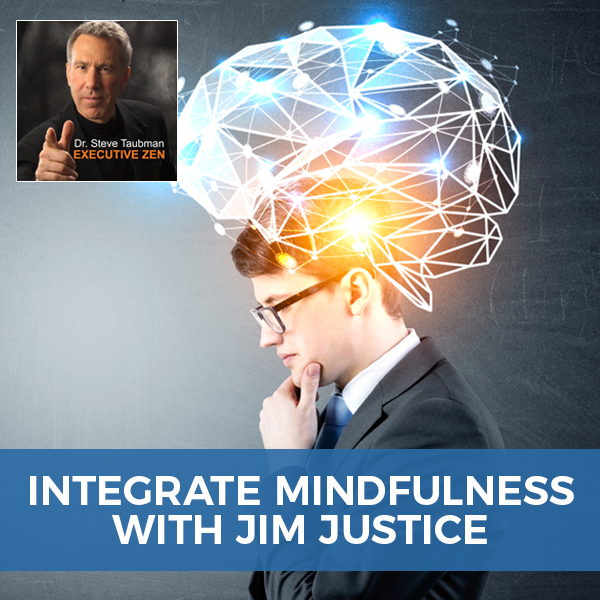
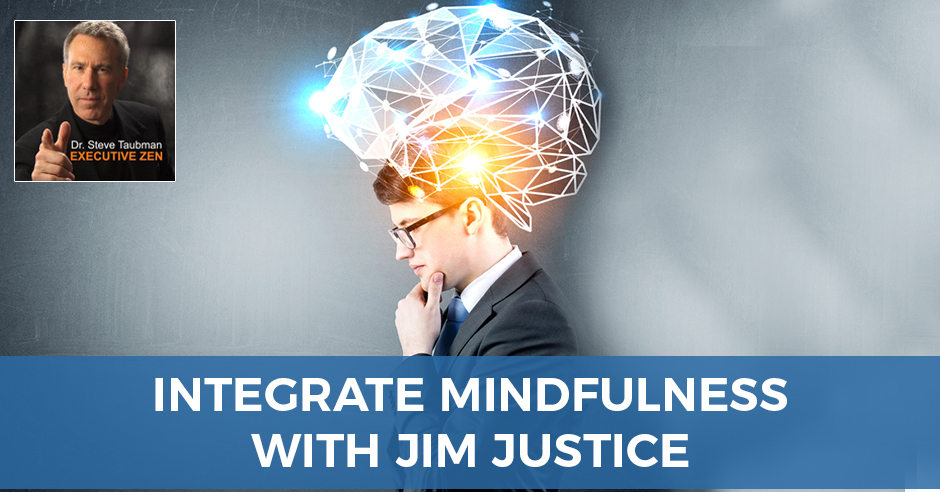
As entrepreneurs, it has become so easy to get caught with the future that we forget to take a break in the present. Anxiety-ridden and tired, we slip into that room that is not anymore serving us. That is why we need to get out of that room and excuse ourselves from all of these things through being mindful. Here, I discuss practical mindfulness with Vibe developer, Jim Justice. He is all too familiar with what we’re going through as he is a consummate entrepreneur also. Learn about a simple app to cultivate wisdom through contemplation and to integrate mindfulness – taking the time off from living in the future – into becoming the master of perspective.
—
Watch the episode here:
Listen to the podcast here:
Integrate Mindfulness with Jim Justice
We have a lot of fun talking about what we love talking about, which is mindfulness and its application to your life. Applied mindfulness as we call it, our ability to control our mental state and quiet our minds and use that to our benefit in our day-to-day lives. This is all about leading consciously and profiting responsibly. If you’ve been following the show, then you know that we’ve been looking at this for a number of different angles, but always with the idea in mind of finding tools for you that will help you to affect the change in your organization, change within yourself and to get the very best out of your life and out of your work. Thanks for being here.
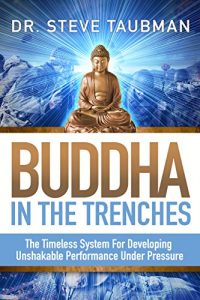
Buddha In The Trenches: The Timeless System For Developing Unshakable Performance Under Pressure
You’re also welcome to pop onto the page we have, which is a special page that was made for a radio show. I was a guest on Jenny McCarthy’s show not long ago. I made a special page for her guest, SteveTaubman.com/Jenny that allowed people access to a free digital download of a good chunk of my new book, Buddha in the Trenches. If you’d like to take advantage of that, go to SteveTaubman.com/Jenny. Until I take that down, that will still be at your disposal, so go ahead and enjoy that. Share this with your friends. Let everybody know what you’ve gleaned from this experience. Feel free to keep it from your competitors and otherwise spread the word far and wide.
We’re talking about integrating mindfulness, which is essentially what we love talking about, integrating mindfulness into your day-to-day life. What’s in the way? What stops us? What keeps us from being able to utilize very simple skills, simple tools, simple practices and rituals, that can have a profound effect on your life and yet how many of us do it? I always ask that question if it’s so great, why doesn’t everybody do it? If exercise is so great, how many people do that? If eating well is so great, how many people do that? We tend to shy away from things that are good for us for any number of reasons. That might be part of the conversation. Another part of the conversation could certainly be how to tweak that part of our mind to be able to inspire ourselves and motivate ourselves to do things that are in our best interest. One of the great things about our guest is that he and his business partner have constructed a process that allows you to do this easily and will allow it to fit into your busy life.
Without further ado, we’re going to be joined by one of a pair of innovators by the name of Jim Justice. Jim is a consummate entrepreneur. He dropped out of college to found his first company, Justice Communications, at the age of twenty. Since then, he’s founded numerous companies spanning consumer products and technology including Grateful Pet, iPIN, which is now owned by Intel and TouchHealth Inc., which is a small communication platform for small medical practices. Jim ultimately earned a BS in Economics from Virginia Commonwealth University and an MBA from Kenan-Flagler at University of North Carolina at Chapel Hill. Jim has been awarded several US patents in electronic payments and secure messaging. That’s all very business-like, but throughout the bumpy ride of entrepreneurship, we all know it is and can be a very bumpy ride.
Jim discovered a parallel path pursuing a spiritual truth. In 2016, Jim attended the Academy of Intuition Medicine in Sausalito where he studied various intuitive and energetic systems along with an exploration of the human state of consciousness. In 2017 along with Steve Sekhon, Jarl Forsman and Bill Gladstone, Jim founded Gratitude Publications to build and market the Vibe mobile app. The idea to create a platform for daily guidance from thought leaders in mindfulness and spirituality has since blossomed. The Vibe serves as a go-to source for a daily dose of mindfulness for those living in a busy world. Before I introduce Jim, in brief passing, Bill Gladstone, his business partner, has been in publication publishing for many years and had worked with some of our favorite people like Eckhart Tolle, Barbara De Angelis, Neale Donald Walsch, Thom Hartmann and on and on. We’re in a very good company here. I’m very excited about bringing our friend, Jim Justice here. Welcome.
How are you?
A lot of the people who come on the show have a tendency to be mobile. They’re out there speaking. They’re consulting and that puts them on the road. Are you a road warrior? Have you been traveling along in this capacity?
Not so much.
Where is home for you?
Sausalito, California.
What a gorgeous place, just a hop skip and a jump away from San Francisco, right there on the bay, a beautiful scenic place.
San Francisco is right up that window. I can get there in ten minutes, but I’ve got everything else I want, quiet and serenity. It’s good.
If some things are so great, why doesn't everybody do it? Click To TweetYou don’t live in a houseboat, do you?
I do. Do you know these houseboats?
I’ve seen those houseboats. If I’m not mistaken, I think that Alan Watts one time lived in Sausalito on a houseboat.
He did. It’s the song, Sitting on the Dock of the Bay. It was written about 100 yards from here. It’s a special place.
A lot more people will probably live there if they can afford to live there. Jim, you’ve walked an interesting road yourself and I can relate to that. I don’t know how much of my backstory you’ve heard, but I was a chiropractor for fourteen years and ended up selling my chiropractic practice and becoming a magician, and then became a hypnotist. I perform corporate magic. I did stage hypnosis shows all over the world. I was the official hypnotist for MTV Springbreak. In the course of that work along with my parallel interests like you in spirituality, I started developing a meditation practice. I started seeing parallels between everything I was doing and meditation, everything that was stopping me and a lack of mindfulness. I started digging in deeper. I ended up writing my first book, UnHypnosis, which is about waking up from hypnosis into a life of being alert, awake and present. That’s been my trajectory. You started out in the world of software engineering, entrepreneurship. Talk a little bit about your backstory.
You mentioned Justice Communications. That was when I was twenty years old. I wrote a business plan on a cable concept for creating an online guide for a cable TV. That’s been done now. I worked on that for a few years. I gave some other people some good ideas. It was a good foray into how not to do some things and how to do some things right. We didn’t start it with a body. We looked for something a little more tangible that we could build and we started a company called Grateful Pet. Grateful Pet was a gourmet gravy for dried dog food. It’s a little company. At the time, small as it was, we knew that there was some levity around the subject. We enjoyed that and played it up. It was very serious to us because we wanted to make it work. We raised $70,000 to build the entire company. We ended up getting it and we had it in 3,000 stores nationwide. It went pretty well. We went from there. That company became an online wholesale distribution system for small pet stores.
As the pet supply industry evolved throughout the ‘90s and into the 2000s, the PetSmarts and the large chains started to take over the majority of the distribution. The little pet stores needed to compete on efficiency as well, so they needed better ways to order products. We stepped in and help them do that. That company is still around. It’s called WholesalePet.com. I went to business school after starting that. I moved to California to start an electronic payment system with the vision that this payment system would be the underlying grassroots payment system for the internet. We had some grand ideas where we were going to take that. It did okay.
We ended up merging with the company in Ireland in 2001. That company subsequently was purchased by Intel years later. We didn’t quite become the PayPal that we were going for but cheers to those guys for doing it. Then I started TouchHealth.com. It’s an online medical form and communications systems for small medical practices. We have a lot of chiropractors using it all the way. We have a lot of psychotherapists that use this. It gives these smaller entities some of the tools that some of the larger entities have at a very low cost.
Even before you started Vibe, you started developing some interest in mindfulness and in a particular way of thinking and being that maybe wasn’t part of your world before that.
Throughout that whole career, I was majorly stressed out. I’m ridden with anxiety and depression in there. It’s a classic lack of mindfulness and a lot of entrepreneurship is because you’re living in the future. You’re focused on your dream. You’re not really enjoying the ride. It looks like people are enjoying the ride. You raise a lot of money. You buy yourself a Ducati and sport around town and party. This is the way it was definitely back in 1999. We were partying like it was 1999. We were internet entrepreneurs and all is good. Along with that, for me especially, you feel like the world on your shoulders, expectations are high. One of the biggest challenges throughout my life has been dealing with expectations. Whenever there are high expectations, it’s an anxiety-inducing situation for me. That is entrepreneurship. You got these forces all driving you away from being present, being grounded and doing the things that we need to be doing to be mindful, healthy and happy.
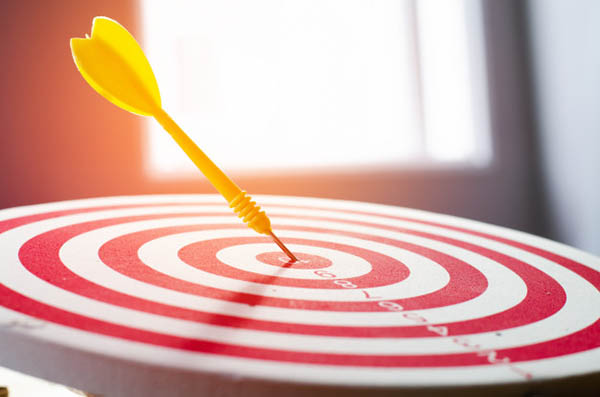
Integrate Mindfulness: Even if you meet your goals, you’ll find out it does not really make you happy anyway because there will be another goal.
I rode that bumpy train all the way through TouchHealth, which is this last company that we’ve been working on. Years ago, I had a good friend who convinced me to do the Academy of Intuition Medicine with Francesca McCartney. I was living in the city at the time. It was in Sausalito. It started off with basic meditation. Through the first year, you work a lot with chakras and grounding chords and some interesting things that your typical business guy doesn’t really get into too much. The second year, you take it a step further and you work on energetic healing. It’s a class for healers and you end up with a degree. The State of California has a degree that you can officially earn in intuition medicine. I got that degree. A lot of healers go to this class, so they can hang a sign saying that they’re certified.
The second year you spent a lot of time learning to physically heal systems in your body. A huge part of that is the psychology component. You’re grounding out the things that are bothering us and keeping us unstable, the anxiety and the depression. That was my first stop into this world. It was a valuable one. I took a basic course in meditation before I did that. It was hugely helpful and learn to meditate on a mantra, which is the very basic of mindfulness. It’s an extremely handy tool.
I’ll reflect a couple of things back. Interestingly, it sounds like your own neurosis, your own anxiety, your own exhaustion. You were working hard. I wanted to also speak to what you’re saying about living in the future. As an entrepreneur, you’re picturing what you want to have happened. You’re working hard. You’re getting some of the perks, benefits and fun stuff that happens along the way but there’s not a lot of grounding and being present in the moment. Sometimes you don’t know it. Sometimes you’re so busy doing that you don’t realize that you’re no longer doing it from a place of passion, but now you are obsessive about it. You’re in this intense energy that’s hard to break free of.
External forces are working you in that direction too. Investors see where they want this thing to be and what they want out of it. You have to live there too.
If we’re talking to business leaders here, we need to be mindful of the fact that none of us have the luxury of just saying, “I think I’m going to go off and live in an ashram for a month and gain serenity as a result of being away from the actual demands of my life.” The demands are still there. I think that the opportunity is to find ways of replenishing ourselves along the way so that we can come back to center while we’re still in the battle or we’re still doing what we need to do.
That would be an extremely helpful way to look at it as long as you maintain where that center is and then you know you can get back to it. It’s something I’ve been working on. This is ongoing work. This is an ongoing experience. There’s a lot of power in perspective. If I can look at my goals and objectives without necessarily becoming infatuated with my goals and objectives or somehow imagining my life meeting my goals and objective, that’s fine. Requiring reaching my goals and objectives to be happy, that’s the problem.
You mentioned this in your book, Buddha in the Trenches. It was just so on point because that’s what we do. We marry our opportunity even our opportunity to be happy with meeting goals. You’re missing everything along the way. Even if you meet your goals, you’ll find out it’s not really going to make you happy anyway because there was another goal. You’re missing so much of life living along the way. That’s something I’ve been personally working on. For sure, it lowers your heart rate and you’ll sleep better. I’m much happier, much better in general than I used to be. I still got a lot of work to do and probably always will.
In my first book, I talk about it playing it like a game rather than like a battle. You’re still trying to win, but there’s still that lightheartedness about it. When I get to that place, I say to myself, “What if I’m retired? What if right now I’m already retired? None of the stuff I’m doing now are things that I have to do. They’re things that I want to do. How will I hold it differently? Would I maybe take a few things off my plate or would I be more efficient with other things? Would I laugh some of the stuff off while I’m am still doing it? I’m not treating it like it’s life or death.”
We both have friends who are retired, who were plainly happy or seemingly happy in what they were doing. I have friends who are retired who are miserable. I have friends that are working who are happy as a clam because they love the experience. They love every day. They love the conversation they’re having, what I’m doing right now. They’re not so set on the goals necessarily. I have friends who are working who are absolutely miserable as well. I don’t know if they’re even related. Your state of happiness is your choice. That’s the hardest thing. I’ve been working on this for years and I still struggle with that. It’s a choice.
We tend to shy away from things that are good for us. Click To TweetA friend of mine quoted on Facebook something from Michael Beckwith. She had asked him how he managed his schedule because his schedule was so incredibly tough. He was one of those road warriors like you’re talking about. He said, “How do you do it? You only sleep four hours, four nights in a row.” He said, “I just put myself in a world where I’ve got plenty of energy.” He just wills himself into the world where he’s got energy. It’s a choice, “If I get a bad night of sleep, I can dwell on it and I’m going to be tired.”
That’s funny because it goes back to the whole thing about the stories we’re telling ourselves as opposed to the thing itself. If something happened and then we tell ourselves, “I’m going to be so tired today.” We’ll actually tell ourselves this is going to be a terrible day. One of my guests is an expert in NLP, Neuro-Linguistic Programming. She says, “The subconscious mind can tell the difference when you say something, whether you’re reporting something or your programming it in for the future.” Saying nothing good ever happens to me. You think you’re just reporting on the past event, but what you’re doing is you’re programming yourself for the future event of nothing good is ever happening to you.
I’m still working on that part of it. They say you basically imagine your future. This conflicts with the simple concept of being mindful. If you imagine the future and you see yourself living in the future that you want, then it will transpire. You have to believe that it’s going to be there. I still struggle with that because the counter to that is too stressful. That’s like saying, “Be careful because if you’re incapable of imagining that, you sink into bad thoughts, you’re going to pay a hefty price.” I don’t really need that stress in my life either. The fear of a negative thought is going to spin my life out of control.
It’s that random negative thought. The problem isn’t necessarily that I had a negative thought. I’ve doomed myself to a future of misery. Rather, what are my dominant thoughts? How am I taking that negative thought and building a cocoon around it by having another negative thought about the fact that I had a negative thought? It’s like, “I just had another bad thought. That was another one and that was another one,” and then the next thing you know all you’re doing is dwelling on the negative. Mindfulness does play a part in that because, in order to recognize that particular dominant nature of thought requires you to get out of thought, you need to be backstage to see it happening. In my world as a hypnotist, I say be your own hypnotist. Program yourself. Come up with your own strategy for what you want. You always know, I’m not that future event. I’m not the thoughts I’m having. I’m the author, not the book. Let’s talk about Vibe. I’m very interested in how you connect with Bill, how you guys made this thing happen. What’s happening to it? What the value is to John Q. Public?
My neighbors here who I became good friends with had a daily inspirational newsletter. We don’t use the word inspirational because inspirational implies temporary endorphin rush. It’s a mindfulness newsletter. They had several thousand users, some Hollywood people who are following them. Reading these things every day and sending comments back, and then I signed up. I thought their stuff was good. Their writing is fantastic. It’s such a story. We started talking about email delivery not being a very good medium for this type of messaging. We talked about the opportunities that we would have if we built an app specifically for delivering this type of messaging. That’s how the whole thing got going. We started talking about building an app for them specifically. I then met Bill who was very dialed into the publication side of this world. Bill and I were involved in an art project together in New York City. Knowing each other, talking with other, as I was working on the app for my neighbors, this was Steve Sekhon and Jarl Foresman.
Talking to them, we started thinking about maybe doing a multi-author platform, allowing other authors to also use this tool we were building for their followers. I spoke to Bill about it. Bill was fully onboard, he loved it. He thought the authors would not only relish the opportunity to put something out there in a premium channel for their followers. They all have content that is already prepared that it just needs a conduit to get to their people. It wouldn’t necessarily be that hard for the authors. We called the authors thought leaders because they take more of a role than just being authors. They actually have somewhat of an instructional role. We built this app. The way it works is in lieu of getting an email each day, you get a notification on your phone. It’s a little bit more in your face as a reminder. Neale Donald Walsch, for example, has posted a new message for you. The main post we try to encourage the thought leaders to keep them to 100 words or less. It’s something that you can read while you’re eating your cereal or before you get out of bed maybe.
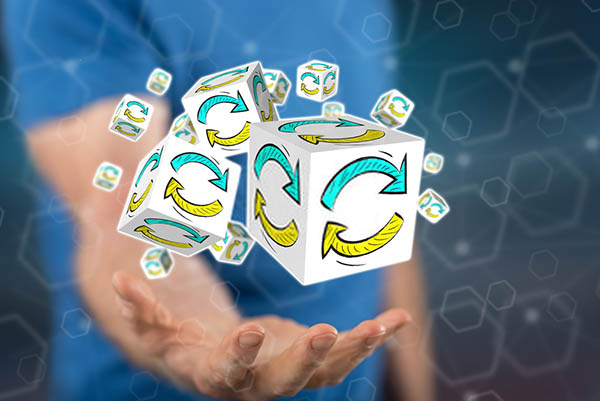
Integrate Mindfulness: Repeat something three times and you will remember.
We have a unique feature, which is valuable and that it will remind you of a few times throughout the day of the main post and that’s called the Vibe. The Vibe is a distilled version of the main post. It could be an affirmation. It could be more of a sagacious statement. In general, it should remind you of the bigger statement. There’s some science behind this. Learning science says and we all know this, my mom used to say repeat something three times and you will remember. It doesn’t always work. It works less the older you get. When you turn 50, you have to repeat something five times. Repeating things, I believe this is right, it doubles your retention rate. If you hear something once, I think your retention rate is about 10%. If you repeat it several times, it doubles. It might get a 20%, 25%. If you use something that you have been taught or that you’ve heard, it gets to 90%. Using means telling somebody else about it, instructing someone else with it or using it in your everyday life. The way the Vibe works is the reminders are not just supposed to serve up a repetitive nature to the message. It was supposed to hit you at a point in your day where you can use this. This is a typical Vibe, it’s Neale Donald Walsch. I love this one. I thought it was very powerful. This is Neale’s post and then he includes a Vibe.
Authors can also have a choice. They can include a short meditation along with their daily post, which is pretty cool. They can also include an audio file, which typically would be them reading the post to you so you might listen to it in the car. This is what you would be reminded with. I have mine set. You can change how often you want to be reminded but mine is set every three hours. It’s a little bit aggressive, but I own the company. He said, “There is no condition that is good or bad. It just is. Stop making value judgments.” It happened to me. I just thought that was a good one. It probably struck me in a good way because I was in a situation where I probably at the time was dealing with something a little stressful. I got to take that message and say, “It just is. Let it go.” The value there is not that I just saw it again. It was also that I got to use it at the time that I got reminded about it. That’s the Vibe. That’s what it does. Right now, we have about nine authors and nine channels. We have some good ones. We have Neale Donald Walsch. We have Barbara De Angelis. Lissa Coffey from Coffee Talk Radio, Jarl Forsman and Steve Sekhon are our own guys. Theirs is an amazing channel.
Bill has his own also.
Bill has one that is a compilation channel. Bill writes it sometimes and then we also bring in some of his new authors that he’s representing. Bill is also an agent for new authors. We have A Course in Miracles Channel now. I don’t know if you saw that. It was pretty cool. It’s written by Gerald Jampolsky. He’s a New York Times number one bestseller. These guys that we have now, they sold over 30 million books. The guys that are on the app are slated to be on it this month. There are some good thought leaders on there and we’re continuing to add people.
This is a backstage question. The authors themselves, are they basically sitting down and writing the day’s Vibe or are you taking the body of their work and creating small pieces, chunking it down in order to deliver it out to the world?
It depends. We will curate for the author if the author wants that. Most of them are writing their own. They don’t necessarily sit down and write them every day. We have a queue. They can go in and write ten and then drip feed. It would be too stressful for those guys to have to do something every night.
A lot of them have the ability and a lot of them are using the ability to provide a meditation of some sort also.
We just added a feature. It’s being used. We want to encourage them to use it more. Lissa Coffey has done a meditation every day. We tell them they can create a library of meditations. They don’t have to create one for every day. You can create ten and then apply one to the mix for that message.
What’s interesting is that message hit you right at the right time. It almost seems there is a certain inherent magic. When you hear something, you’re ready to hear it, it just goes in a certain way. Sometimes it’s always the right thing you needed to hear it right then. I hear that from readers of my stuff all the time. It’s like, “I just got it just when I needed it.” You probably need it tomorrow too.
There’s a sense of synchronicity in this business. You get Vibes sometimes and it’s always good, but sometimes it’s more on point than others.
If you imagine the future and you see yourself living in the future that you want, then it will transpire. Click To TweetIt’s like a fortune cookie.
In general, these are valuable messages regardless of what you’re doing with it. It’s good when we talk about the theme, integrating mindfulness. It’s hard to keep continuity in your mindfulness world throughout your day. I meditate every morning with few exceptions. We’re a guru over your shoulder. Something that will keep you integrated, you maintain the continuity of that mindful state throughout the day.
I love that idea of the guru over your shoulder. You’re like an accountability partner for my mindfulness commitment. I’m committed to mindfulness, but maybe I slip or I forget or something irritating happens. It’s a lot more satisfying to lash out and to come into a place of serenity and this is just one way. In Buddha in the Trenches, I talk about assembling your lifeboats. This is one of the lifeboats. It’s a system that’s designed to tease you back into consciousness when maybe you don’t have the necessary strength or awareness to do it yourself.
I love the concept of perspective because perspective is so powerful. I don’t want to say easy, so the problem is it’s not easy necessarily to change your perspective. The difference between viewing an event in a negative sense and viewing it in a positive light, it’s simply a switch. That’s what a lot of these messages do in the middle of the day. That was a switch for me. Whenever I read that, I was dealing with something negative. It’s simply in a microsecond made you realize that there’s another way to look at this whatever it is. Whatever I’m facing right now is not a life-defining moment. It was just irritation. Whatever it was, I felt much stronger and better because I didn’t let it affect me anymore. I didn’t let it change my decision making. Perspective, you don’t necessarily have to trick yourself. You have to become a master of perspective.
There are a number of things that we have at our disposal that can have that impact on perspective. Humor can be useful in that way. Sometimes you see it through the eyes of humor. Somebody makes a joke about it and suddenly it diffuses the situation. Do you remember the movie Steel Magnolias?
Yes.
In the movie, Sally Field is the mom and the daughter is Julia Roberts. I think Julia Roberts, it’s one of her first movies. She has some disease and she died. Sally feels that at the funeral and she’s crying and despondent. Then she’s like, “I just want to hit something. I’m so angry. I want to hit something.” Olympia Dukakis grabs a hold of Shirley MacLaine who’s the curmudgeon in the movie, “Here, hit Ouiser.” Sally Field stops in her tracks and then she starts to laugh. It’s that laughter through tears thing, the ability to take even the most trying, horrible and painful moment. We all have the capacity even in those most powerful and painful times to shift our perspective to go to a different place and have more resources. Maybe something that’s less painful or less restrictive.
You’re a comedian, right?
I’m a magician and a hypnotist. I’m sometimes accidentally funny too. There’s humor in it. Yes.
I think that’s the crux of humor. I think of Seinfeld. Seinfeld, they take horrible human situations and adjust the perspectives, so they are funny.
It takes wisdom. It takes intelligence. It takes a willingness to step out of your usual way of looking at things. The Vibes can be that stimulus. That can be that thing where I’m here at this level of dealing with whatever I’m dealing with. All the thoughts I’m having are at that level of consciousness, but then along comes the guru over my shoulder and says something, it essentially raises my consciousness. It raises me to a different perspective where I can now apply a new perspective to the existing situation.
It happens in a microsecond. It really does. There might be a moment of consideration.
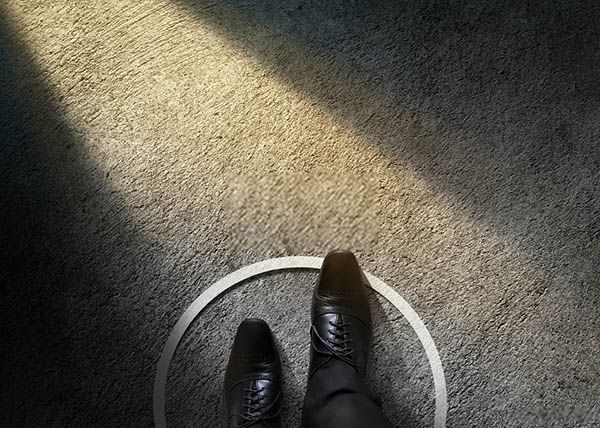
Integrate Mindfulness: It takes willingness to step out of your usual way of looking at things.
Do I want to stay attached to this? Maybe I want to still be mad or irritated.
We get feedback. That’s what people tell us. It’s a very new app. We have bugs in there. We get support calls. Sometimes people are panicking. They’re like, “I’ve got to get this working.” I’m like, “Really?” They’re like, “No, you don’t understand. I’m in the public.” This one person called. She said, “I’m in the publishing business. You don’t know what my days are like.” I’m like, “Okay.” She is almost treating it like a drug. Talk about a reward.
That moment of recognition that you’re panicking about not having the app that’s helping you not panic is very funny. I remember one day I was late for meditation. I was going to go home and meditate. I was driving home. I was in traffic. I had planned to meditate too and I wasn’t getting home in time. I was getting agitated in the car because I was going to get home late. I was like, “When is being here now the right time? Why not be here now in the car and go home to meditate rather than being upset?” That’s the whole practical side of this thing. I could always apply it right now. I can always picture a Vibe. What would a Vibe say right now if it were able to read my mind and realize how upset I am being about the fact I don’t have a Vibe right now?
How long did it take that perspective shift?
In a moment. It’s instantaneous. It’s powerful stuff. With the meditations that the thought leaders themselves might put in there, is there also an element of the app where people meditate? I think there was a timer or something. We would set a timer to meditate.
There’s a basic meditation timer. That’s our next stop to further enhance that part of the app. You can set a timer for ten minutes or five minutes or 40 minutes and meditate to it. It’s very basic. It’s very nice because it’s clean and simple.
I saw a gong at the beginning, a little gong at the end. It was like a soothing sound to let you in and let you out of meditation. That was nice.
We added one track behind it. It’s an option and you can turn it on. It’s part of chakra meditation. The singing bowls, it’s a hard chakra resonance, so you can turn that on. We have that now. That section is going to get built out quite a bit in the next few months.
I know you said you could set X number of times that you would receive a Vibe based on that day’s message. That’s one thing that I could do. Say three times a day I want to get a reminder about what Neale Donald Walsch said. Can you also set that to remind you to meditate three times or is that both the same thing? At 2:00, it goes off. It says, “Here’s the Vibe. Click here to do the meditation.”
No, but that’s a good idea. That’s clever. You get the reminder. You can tell yourself that’s the time to meditate. Part of what we wanted was something that didn’t demand a lot of the user. It’s mindfulness for busy people because we expect you to meditate. We expect you to learn to tackle your thoughts in meditation because that’s what you’re learning to do. The Vibe works well with that meditation practice. It gives you the contemplation. All mindfulness is not necessarily related to Buddhism. If you look at Buddhism, a big part of that is contemplation, sitting with thoughts. This is the function that we provide. We provide you something in the morning to contemplate. That’s important. It’s quick. Part of the Vibe’s design is it doesn’t take much time. We’re talking one minute read at the beginning of the day. You probably should get two or three reminders during the day. That tiny bit of time can be so powerful.
Our minds are constantly swinging from the branches like a monkey, from thought to thought. Click To TweetIt’s hugely powerful and a lot of the studies now on these things that break our set, break our pattern, take us away from our habitual thinking that interrupt it even for a moment like some of the studies on astonishment. Show people a beautiful scene on their desktop for a minute and it improves their productivity and their endurance because it interrupted that constant never-ending stream of thought. Contemplative thought, quiet mindedness, beauty, astonishment, all those things are useful tools to keep us from spinning ourselves tighter and tighter to the point where we’re totally exhausted, totally overwhelmed and not getting any fun out of life. This is powerful stuff. I appreciate you mentioning that it is really quick. One of the takeaways from this is if you’re a busy business person out there and you’re trying to up your productivity and lower your blood pressure, get the Vibe. Get the app. I think you’d given a week away for free too. Am I right about that?
Yes, you get a week to try it out. You can bail if you want. It’s $2.99 a month after that.
It’s well-worth your time. Tell the people, Jim, if they want to pursue this further, if they want to learn more about Vibe and they want to do it, what do they do to get that?
We have a website that’s pretty good. It talks a lot about the app and who’s on it. It’s Vibe.me. We didn’t really talk about the name. There’s a large school of thought that relates vibrational energy to your state of being, your state of health and your state of mindfulness. Generally, people relate a higher vibration to a state of being mindful and alert. That’s where the name comes from. You can get it at Vibe.me. You can learn all about it there and then you can click the Download App button there. It should detect what phone you’re on and take it to the right store whether it’s Android or Apple.
On the other hand, if you’re somebody like Bill Gladstone, you can’t do that because you don’t have a smartphone.
One of our company owners doesn’t even own a smartphone.
Hopefully, he’s reading this and we’re shaming him to change his ways.
He loves the fact that he never got suckered into this frenzy.
There’s something to be said for being your own person and not being pulled into these cultural imperatives. You guys are making valuable use of it and that’s the important thing. You’re giving it to the people who are going to be on there anyway. Let it interrupt your habitual ways. First of all, I want to thank you, Jim, for being with me. I want to remind everyone, go to Vibe.me to pick up the app and learn more about it. Try it out for a week and see what you think. I’ve only had it for 48 hours. I’m enjoying it. I think it’s a great thing. It’s a useful tool. We’re all looking for applied mindfulness, meaning something we could do during the day that doesn’t require us to run off to the ashram to get some consciousness. This is a good thing for you to use. Another good thing for you to use is my book, Buddha in the Trenches. It will help you to release some of your stress and bring happiness into your day-to-day life. This has been a lot of fun.

Integrate Mindfulness: There’s something to be said for being your own person and not being pulled into these cultural imperatives.
We always like to end with a quote for the day, a metaphor for the day and a challenge for the day. The challenge is going to go to Jim. The metaphor, this is the classic one, it’s the monkey mind. In Buddhism, we talk about the monkey mind. Our minds are constantly swinging from the branches like a monkey from thought to thought. We almost never get a moment of silence. That’s why in picking up a tool like the Vibe tool, you’re trying to interrupt the monkey mind. You’re trying to interrupt the constant stream of thought. Not that you’re going to stop thinking, but rather you’re going to find yourself at a place other than that constant stream and you realize you’re not your thoughts. The metaphor is the monkey mind, think about monkey mind and how that applies to you.
The quote is not an exact quote, but this is something that I heard Ram Dass say years ago. He was talking about the difference between psychotherapy and mindfulness practices or meditative practices. He said, “If you think of the mind as a room, conventional psychotherapy is like rearranging the furniture in the room. Each thought is part of your mind. Your mind is a room and the thoughts are the furniture. You’re trying to rearrange the furniture.” He said, “Mindfulness is leaving the room.” Being able to get out, not to have to figure out where everything goes, but to be in a different place of the process. It’s perspective. Leave the room to be able to gain enough perspective to know what to do when you go back to the room. That’s my quote for you. Jim, if you would be so kind, I love to see if you could share a challenge of some sort to our guests that they can take with them for the week.
This is a big one. It may not be just for the week, but to become a master of perspective. Let’s make that the lifelong endeavor because that’s what that is. Recognize those moments when a shift in perspective can make all the difference. Shifting your perspective when you’re reacting, when you’re in a state of anger or frustration is very challenging to learn. It’s difficult to learn the trick, but maybe for the week just recognize at least those moments where you have an opportunity to shift your perspective. That alone will probably help you shift your perspective a little.
Saying to yourself is probably a better way to look at this. It’s probably a different place which I can see this. If I were enlightened, this wouldn’t bother me.
That’s one way to do it if I were enlightened.
The other one for me is people will always say when they’re in a crisis, they someday will look back at this and laugh. I’ll say, “Why wait?”
It’s all about that moment and you have a choice. There is a choice. Bad things happen. You don’t have a choice if you’re running into the back of another car or if you’re watching your house burn down. There are a lot of people who are challenged this week.
This has been tough and our hearts go out to all those people. Hopefully, they’ll find peace and serenity through this very challenging time. Jim, thanks so much. Please share my sadness with Bill that we didn’t get to have him join us on this as well. We’re going to definitely want to pick back up with him at some point. Maybe we’ll get him a smartphone for his birthday. I’ve enjoyed spending some time with you and hopefully, someday we’ll do some business together. Maybe I’ll be one of your Vibers.
Yes, maybe you will. I love your message. It’s fantastic. It’s so important.
I appreciate that. Thanks so much. To the audience, remember to lead consciously and profit responsibly. Jim, thank you so much for your time. Feel free to reach out if you have any questions, any feedback at SteveTaubman@Gmail.com. Thanks. Take good care.
Important Links:
- SteveTaubman.com/Jenny
- Buddha in the Trenches
- Jim Justice
- Vibe
- Bill Gladstone
- UnHypnosis
- WholesalePet.com
- TouchHealth.com
- Neale Donald Walsch
- Barbara De Angelis
- Lissa Coffey
- Jarl Forsman and Steve Sekhon
- A Course in Miracles Channel
- Vibe.me
- SteveTaubman@Gmail.com
About Jim Justice

Jim is a consummate entrepreneur, dropping out of college to found his first company, Justice Communications, at the age of 20. Since then, Jim has founded numerous companies spanning consumer products and technology including Grateful Pet, iPIN (now owned by Intel) and TouchHealth, Inc., a communication platform for small medical practices. Jim ultimately earned a B.S. in Economics from Virginia Commonwealth University and an MBA from Kenan-Flagler (at University of North Carolina – Chapel Hill). Jim has been awarded several U.S. patents in electronic payments and secured messaging.
Throughout the bumpy ride of entrepreneurship, Jim discovered a parallel path pursuing his spiritual truth. In 2016 Jim attended the Academy of Intuition Medicine in Sausalito, CA where he studied various intuitive and energetic systems along with an exploration of the human state of consciousness.
In 2017, along with Steve Sekhon, Jarl Foresman and Bill Gladstone, Jim founded Gratitude publications to build and market the Vibe mobile app. The idea to create a platform for daily guidance from thought leaders in mindfulness and spirituality has since blossomed and the Vibe serves as a ‘go to’ source for a daily dose of mindfulness for those living in a busy world.